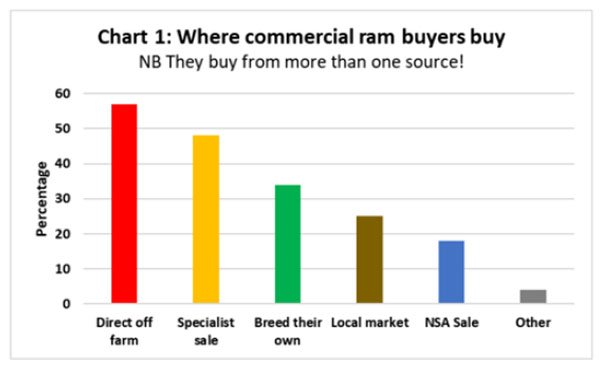The Southdown, in spite of its good looks, easy temperament and tasty meat, is primarily classified as a Terminal Sire Breed to be used by commercial farmers on their crossbred ewes to produce meaty lambs. And, when I set out breeding Southdowns my aspiration was, and still is, to sell their easy lambing and early finishing to commercial farmers.
Every farmer/customer is different, so it is not always easy to identify what it is - in general - that a commercial farmer wants. However last year I came across a report prepared by renowned sheep experts Lesley Stubbings and Kate Phillips with the help of the NSA, which gave some valuable insights into commercial farmers’ thinking and their choice of ram. The report, published in 2017, titled “Improving the Welfare and Longevity of Rams in Commercial Flocks” makes a number of valuable recommendations on ram welfare aimed at commercial farmers, but there is also some valuable market research on ram buyer’s behaviour and thinking. And, although the study was conducted five years ago, I suspect little has changed (apart from lamb price) in the intervening years.
With the authors’ agreement I have extracted relevant market research information and made some personal comments in italics. Please also note that I have redrawn the graphs so the percentages are approximate as I did not have the raw data.
Quantitative and Qualitative Market research
As a basis for the report the researchers conducted a survey of commercial (non-pedigree) farmers with >200 ewes: 586 farmers participated and most had flocks of 251-1000 ewes. The survey was then followed up with 10 focus group meetings (across the UK) reaching 98 farmers who had completed the survey.
The report highlighted some valuable Key Performance Indicators (KPIs) for rams (see box) that ram buyers ought to be considering - whether they do is another matter.
Ram Longevity
In general, the expectation was that a shearling ram should last 4-5 years and would cover 40-50 ewes/year. Most farmers bought shearling rams (70%), with 21% buying ram lambs and 9% (probably) buying older rams. It appeared that most (70%) buyers were satisfied with how long rams lasted, with just over 12% being dissatisfied. (NB A higher proportion of dissatisfied farmers paid more than £500 for their ram). However, data on ram history showed that on average rams were only lasting 3.8 years with those in larger flocks having a shorter flock life (3-4years) than those in medium or small flocks.
Ram Performance Indicators
Ram life in the flock e.g. 4 years
Ram lifetime output of lambs e.g. 272 lambs
Cost of the ram per lamb reared e.g. £1.84 for a £500 ram
Cost of the ram per kg carcase e.g. 9.2p/kg for a 20kg carcase
Where to buy and what to pay
The most common way to buy rams was direct from the breeder (57%), approximately 48% at a specialist (breed) sale while c.34% bred their own and of course many farmers will use more than one source. These results are summarised in Chart 1.
There is, of course, a huge variation in price buyers were prepared to pay. Chart 2 shows prices ranging from under £200 to more than £1000 with most saying they paid £300-600. Apparently several commented that “a ram is worth 10 fat lambs” that would be well over £1000 at todays prices … if only!
What were the factors influencing buying decisions?
The survey asked ram buyers how important specific factors were when choosing which ram to buy: 71% said health status was the most important, compared to less than 30% attaching the same priority to price, while conformity to breed type was second most important reflecting perhaps that the buyer was wanting the “characteristics” of that breed. Recording with EBVs and Index (sadly for me) were the least important factors.
Health: what did they really know/want?
When quizzed about health information two thirds said they knew everything/most things about vaccinations. However, 50% or less had the same amount of knowledge of feeding levels or worming/ectoparasite regimes. This was discussed at length in the focus groups, as there was a significant mis-match between the emphasis on health status as a selection criterion and actual knowledge. Delving into this further, health knowledge varied depending on the source of rams: 80% of those buying direct from the breeder knew everything/most things about vaccinations (or knew they could find that out from the breeder?). 60% said the same for feeding, worming and ectoparasite control. Only 45% of those buying in the market knew everything/most things about vaccinations. Although it was noted in the focus groups that there was also an element of distrust in the information ram buyers are given by vendors. One other observation from the focus groups was that Maedi Visna (MV) was not considered important: MV accredited rams were bought incidentally rather than deliberately. (Though it might be argued that the extra effort involved with MV accreditation and quarantine etc could provide a useful surrogate for good health status).
Ram feeding and after care
There was a clear message that commercial farmers wanted healthy rams,” typical of the chosen breed” that were not dependent on concentrates. Commercial farmers did not want to feed rams – but will do so if in poor condition. Interestingly a clear message from the report was that commercial farmers tend to be somewhat negligent of ram health and nutrition – often forgetting to worm, vaccinate and feed them until too late.
However it was noted that the more progressive commercial farmers were wanting to buy rams earlier rather than wait for ram sales – by visiting breeders and buying earlier they could have the pick of the stock and have sufficient time to quarantine and ensure the rams were in the right condition for work.
So what are the take home messages from this market research:
Successful commercial ram sales depend on building a long-term relationship with customers who will buy direct from you.
Breed sales may be a useful shop window. but unless commercial ram buyers are looking for Southdowns they are unlikely to come to a Society sale.
Build your reputation with your clients by providing the information and most importantly good quality, healthy stock that has not been forced or overfed.
Many commercial ram buyers are willing to pay a reasonable/fair price for rams.
Patrick Goldsworthy
Acknowledgements: Kate Phillips and Lesley Stubbings for letting me plagiairise their report.
The report was funded by the Norman Hayward Fund of the BVA Animal Welfare Foundation





